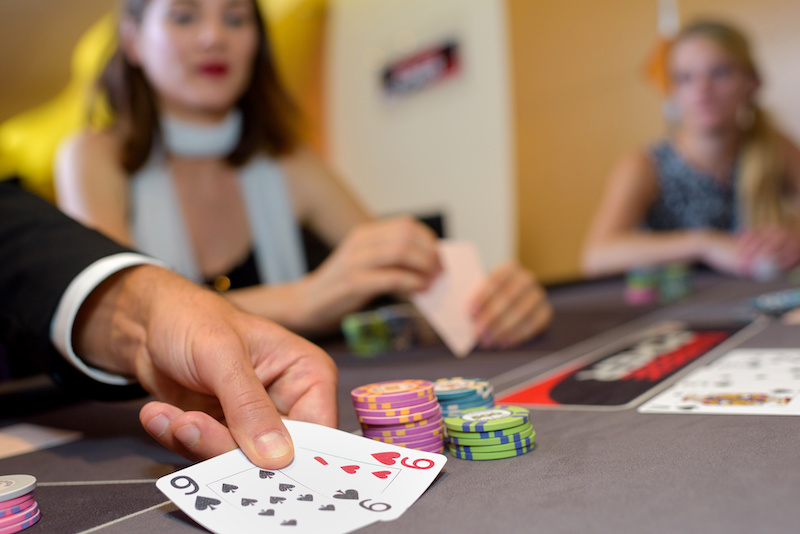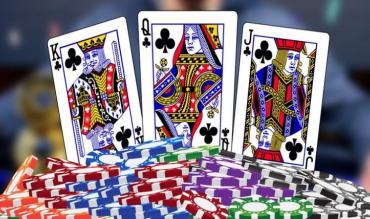The old poker maxim that you have to know when to hold'em and know when to fold'em is much more than a cliché when it comes to Mississippi Stud Poker. It's what the Mississippi Stud strategy is all about.
Mississippi Stud, created by Mark Yoseloff in 2005, has become a casino favorite for its straightforward gameplay and strategic depth. Unlike traditional poker variants, you're playing against a paytable rather than other players or a dealer.
Play opens with an ante, then each player receives two cards face down and three community cards are dealt face down at the center of the table.
After that, there are three opportunities to bet from one to three times your ante. Each time you have to ask yourself, "Do I hold 'em and make the extra bet, or do I fold 'em and save my money?"
The object is to finish with a five-card hand of a pair of sixes or better. The dealer does not get a hand, and you do not have to beat the dealer or other players.
If you finish with a pair of 6s through 10s, you get your bet back. With a pair of Jacks or better, the payoff is even money - you get your bet back plus an equal amount in winnings.
Moving up the pay table, you're paid 2-1 for two pairs, 3-1 for three of a kind, 4-1 for a straight, 6-1 for a flush, 10-1 for a full house, 40-1 for four of a kind, 100-1 for a straight flush and 500-1 for a royal flush.
After you ante and the cards are dealt, you may look at your two cards and choose either to bet or fold. Next, the first community card is turned face up, you again must choose to bet or fold. Then the second community card is turned up, you have one last bet/fold choice. Finally, the third community card is turned up and the live casino dealer pays the winners.
If this article interests you, keep reading. Alternatively, explore other topics like blackjack strategy, roulette strategy, and craps strategy.
Mississippi Stud Basic Strategy: The Point System
The optimal strategy for Mississippi Stud, verified by gaming mathematicians including Joseph Kisenwether's work, starts with assigning point values to cards corresponding to their value if paired up.
Deuces, 3s, 4s and 5s bring no payoff if paired up, so for strategy purposes, those are zero-point cards. One-point cards are 6s, 7s, 8s, 9s and 10s - the cards that will get your money back if paired. Pairs of Jacks, Queens, Kings and Aces bring 1-1 payoffs, so faces and Aces are two-point cards.
When do you hold 'em and when do you fold 'em? Let's check out guidelines for each betting opportunity.

After You See the First Two Cards, Bet With Any of These Hands:
Bet 3x your ante if you have a pair of 6s or better. That start guarantees you will do no worse than getting your money back, your best play is to bet the maximum at every opportunity.
Example: You're dealt 9♠ 9♥. This is an automatic 3x bet. Even if no more 9s appear, you're guaranteed at least a push, with excellent chances to improve.
Bet an amount equal to your ante if you have at least two points, according the rankings above. Two middle cards, such as an 8 and a 6, are one point each and two points for the hand, so you stay in play. It's also two-point hand if you have a Jack or better along with a low card. However, two low cards, or a low card and a middle card, are not strong enough to bet. Fold those instead, with one exception listed below.
Bet an amount equal to your ante if you have two cards of the same suit, 6-5 or better. Without both cards being in the same suit, 6-5 is just a one-point hand. However, 6-5 suited opens the possibility of flushes, straight flushes or straights, so it's worth making a minimum bet to see another card.
After You See One Community Card, Bet With Any of These Hands:
Bet 3x your ante with any paying hand.
Bet 3x your ante with three parts of a royal flush. Even if the cards are not consecutive, three cards of the same suit, 10 or higher, packs a lot of value with possible high pairs, straights, flushes and in some hands, straight flushes as well as the royal.
Bet 3x your ante with three parts of a straight flush with no gaps and 5-6-7 or higher; with one gap and at least one high card; or two gaps and at least two high cards. You wouldn't want to make the 3x bet if you have 6-7-9 suited, because the gap between the 7 and 9 means one of the remaining cards must be an 8 and the other either a 5 or 10 to complete a straight or straight flush. With 5-6-7, you could complete a straight or straight flush with 3-4, 4-8 or 8-9.
Example: You have 8♦ 9♦ and the first community card is the 7♦. That's three to a straight flush with no gaps (7-8-9). Bet 3x! You have multiple ways to make a paying hand.
More ways to make the paying hand means the hand is more valuable with consecutive cards.
Bet 1x your ante with any other three suited cards. This is where a hand such as 6-7-9 suited falls. It's good enough to make a minimum bet, but not the max.
Bet 1x your ante with three parts of a straight and 4-5-6 or better with no gaps, and at least two middle cards or higher if one gap. That means 5-7-8 of mixed suits is playable since two cards could get your money back if paired, but 4-5-7, with only one middle card, is not.
Bet 1x your ante with at least three points. If your hand doesn't meet any of the above criteria, it's still playable with at least three points. Examples include 6-8-10 of mixed suits, with one point for each card, or Queen (two points), 9 (one point) and 3 of mixed suits.

After You See Two Community Cards, Bet With Any of These Hands:
Bet 3x your ante with any paying hand.
Bet 3x your ante with any four cards of the same suit. Regardless of whether there are any straight flush or royal flush opportunities, the 6-1 payoff on flushes makes it worth your while to see if the last community card is the same suit or at least matches one of your middle or high cards.
Bet 3x your ante with any four consecutive cards, 8 high or better. The minimum potential straight for a 3x bet would be 5-6-7-8 of mixed suits. There are eight possible cards to complete the straight - the four 4s and the four 9s - and you have a chance with the 6, 7 and 8 at a pair that would return your bet.
Bet 1x your ante with any other four-card straight. With consecutive cards that are 7 high or lower or with an inside draw such as 6-7-8-10, you don't want to fold, but you don't want to bet the max, either.
Bet 1x your ante with a low pair. If you've stayed through earlier hands and the best the fourth card brings is to pair a 2, 3, 4 or 5, it's worth a minimum bet to see if the final card brings three of a kind or two pairs.
Bet 1x your ante with at least four points. You know the drill by now. A hand such as Jack (two points), 10 (one point), 7 (one point) and 4 (zero points) gives you just enough chances to pair up for a paying hand to stay to see what the fifth card brings.
Bet 1x your ante with three middle cards and at least one previous 3x raise. Let's say you raised three times your ante with a suited 8-9 after two cards, one time the ante after a 3 of the same suit on the third card, then the fourth card brought a 7 of a different suit.
Your final hand of 3-7-8-9 of mixed suits would ordinarily be a folding hand, but your initial 3x bet means you have an extra stake in the hand. The hand isn't a good one, but over the long haul, it cuts your losses slightly to play the hand rather than fold a hand in which you have so much invested.
Essential Mississippi Stud Tips
Here are the most important Mississippi Stud poker tips to remember:
- Never bet 2x your ante - the optimal strategy calls for either 1x or 3x bets only. There's no mathematical advantage to betting 2x in any situation.
- Pairs of 6s or better are automatic 3x raises from the start, as they guarantee at least breaking even.
- Low pairs (2s through 5s) become playable after you see community cards that give you draws to two pairs or three of a kind.
- Suited connectors 6-5 or better are worth a minimum bet even with low point values, thanks to flush and straight possibilities.
Many casinos also offer an optional Three-Card Bonus side bet based on the three community cards, typically paying for a pair or better.
The House Edge
Given that strategy, Michael Shackleford calculates the house edge at 4.91% of your ante, or 1.37% of your total wagers. That makes it one of the better poker-based table games in modern online casinos, and well worth learning when to hold'em and when to fold'em.


